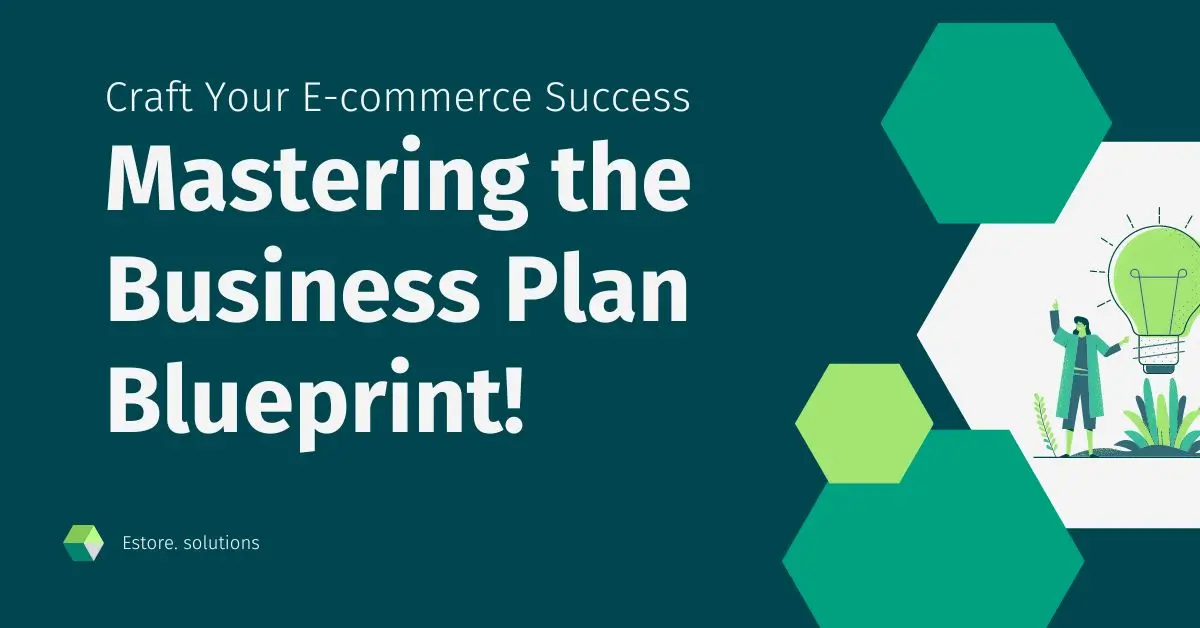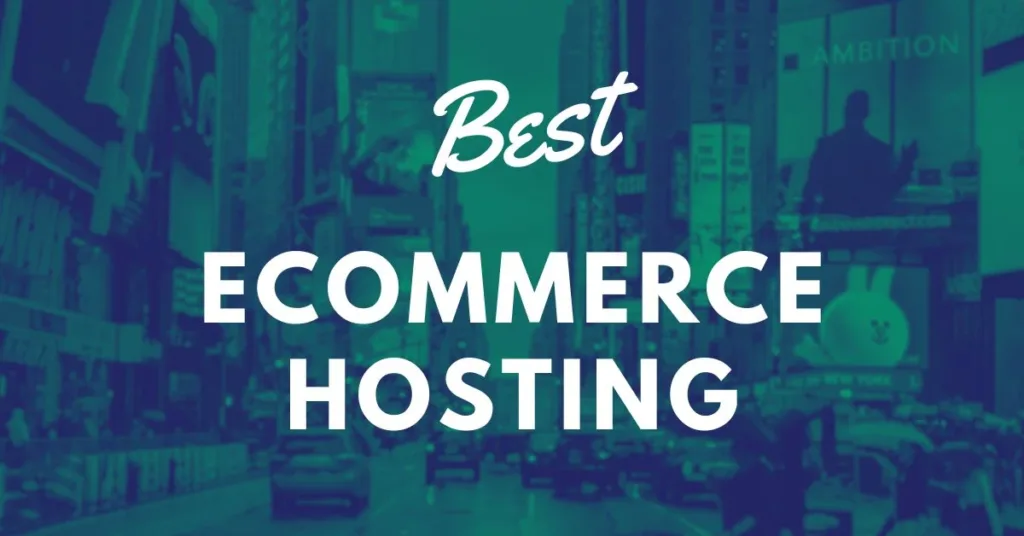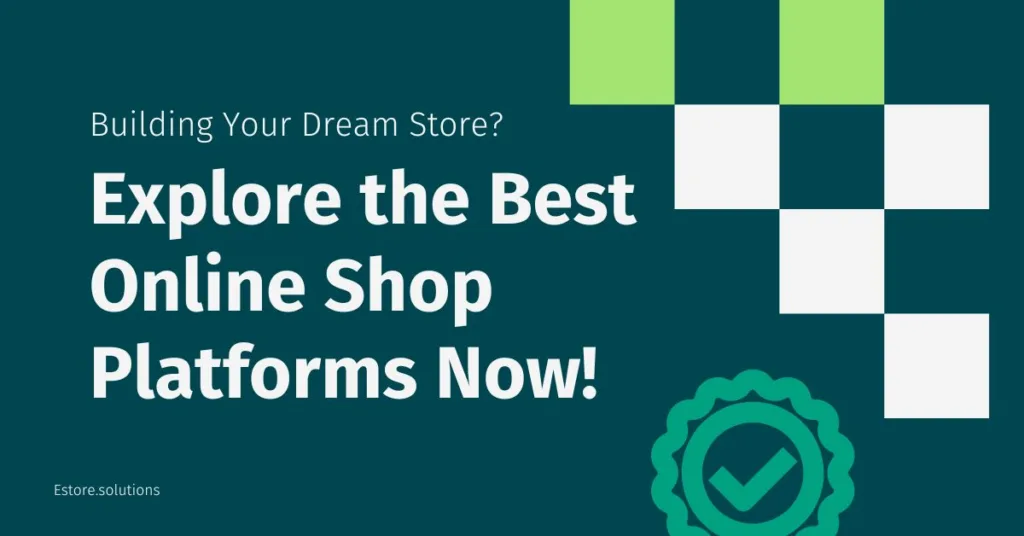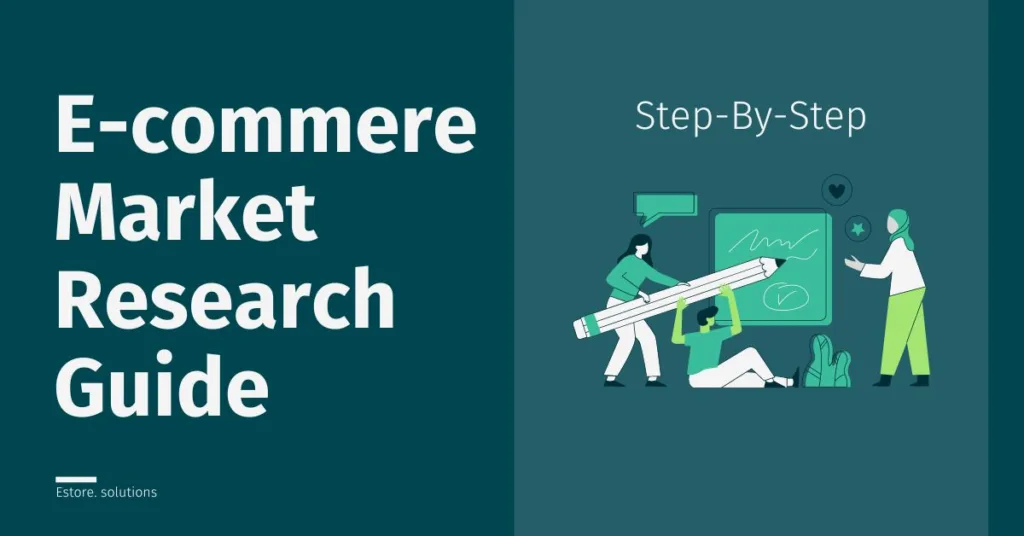Embark on your e-commerce journey armed with a strategic business plan. From the essentials of an online retail business plan to detailed e-commerce strategies, learn how to navigate the digital marketplace successfully. Explore examples tailored for clothing and jewelry e-commerce, and discover the key elements in implementing a robust e-commerce plan. Whether you’re a startup or seeking business upgrades, our guide is your compass in the dynamic world of e-commerce.

Considering the value of this insightful guide, why not share it with fellow entrepreneurs? Encourage your network to explore the strategies outlined at estore.solutions and provide feedback for tailored content upgrades. Together, let’s elevate the ecommerce landscape.
[ez-toc]Introduction: E-commerce Business Plan
Importance of E-commerce Business Plan
In the realm of online business, having a solid e-commerce business plan is like having a roadmap for a successful journey. Think of it as the guiding star that steers your ship through the vast digital sea. This essential document outlines your goals, strategies, and unique selling points, ensuring that your online retail venture sets sail on the right course. Without a clear business plan for e-commerce, it’s like navigating without a compass – you might drift aimlessly. In this section, we’ll delve into why this blueprint is the cornerstone of your e-commerce success, offering insights that transcend the complexities often associated with the term “business plan.” Get ready to understand the significance of this foundational document in the world of e-commerce business development strategy.
Role of a Business Plan in E-commerce
- Strategic Navigation: Your e-commerce business plan acts as a strategic compass, guiding you through the competitive digital landscape.
- Goal Setting: It’s your tool for setting clear goals and objectives, laying the foundation for a successful online venture.
- Unique Selling Proposition (USP): Uncover and define your business’s unique selling proposition, the secret sauce that sets you apart in the e-commerce world.
- Adaptability: A well-crafted plan is your playbook, helping you adapt to market changes and challenges in the dynamic e-commerce space.
- Stakeholder Understanding: It aids in communicating your vision to stakeholders, ensuring everyone is on board with your e-business strategy.
- Risk Mitigation: By identifying potential risks, your plan becomes a shield, allowing you to proactively mitigate challenges and secure your e-commerce success.
Executive Summary
Key Components of Your E-commerce Business Plan
To embark on your e-commerce journey, you need a clear roadmap – your business plan for e-commerce. This document encapsulates crucial elements for success. Begin with a detailed business description, outlining your niche, be it clothing or jewelry. Dive into a comprehensive market analysis to identify your audience, analyze competitors, and support your insights with data. Structure your team and highlight skills in the organizational section. Specify the products or services you offer, especially if you’re in clothing or jewelry. Craft a winning marketing and sales strategy, covering social media, SEO, and pricing. Estimate costs, revenue, and funding options in the financial projections. Don’t forget to foresee and plan for potential risks in the risk analysis section. This holistic approach ensures a robust foundation for your online retail business.
Main Goals and Objectives of Your E-commerce Business
- What are Your Business Goals?
- Clearly articulate the overarching objectives that drive your e-commerce venture. Is it growth, market dominance, or a unique customer experience?
- How Will You Measure Success?
- Define key performance indicators (KPIs) to quantifiably measure your progress. Will it be revenue milestones, customer acquisition rates, or market share?
- What Timelines Are You Setting?
- Establish realistic timelines for achieving your goals. Are you aiming for short-term wins, or is this a strategic, long-term vision?
- Are There Specific Milestones?
- Break down your goals into manageable milestones. What achievements will mark significant progress along the way?
- Do You Have a Unique Selling Proposition (USP)?
- Highlight what makes your online business stand out. Is it unbeatable prices, exceptional service, or exclusive products?
- How Will You Adapt to Market Changes?
- Address adaptability in your objectives. What strategies will you use to stay ahead in the dynamic e-commerce landscape?
By answering these questions, you not only set clear goals but also establish a roadmap for achieving and adapting to success in the competitive e-commerce market.
Business Description
In the detailed business description, showcase the essence of your online venture, whether it’s clothing, jewelry, or another niche within the vast e-commerce landscape. Dive into your business model, elucidating how your operations will unfold—will you be a trendsetter in clothing fashion or specialize in unique jewelry designs? Highlight your unique selling proposition (USP), emphasizing what makes your e-commerce business exceptional. This narrative not only shapes the identity of your venture but also lays the groundwork for a successful business plan for e-commerce.
Unique Selling Proposition (USP) of Your E-commerce Business
In the realm of e-commerce, your success hinges on a compelling unique selling proposition (USP). Your USP is the beacon that draws customers by offering something distinctive.
For instance, if your e-commerce business focuses on clothing, your USP might be affordability without compromising on style, providing trendy fashion accessible to all. On the other hand, if jewelry is your niche, a USP could be the exclusivity of handmade designs, offering customers one-of-a-kind pieces. Clearly defining your USP in the business plan for e-commerce not only attracts your target audience but also sets you apart in the competitive digital marketplace.
Market Analysis
Conduct a Thorough Analysis of the E-commerce Market
- Identify Your Target Audience and Segmentation:
- Pinpoint the audience most likely to engage with your e-commerce business. Understand their preferences, demographics, and behaviors to tailor your strategies.
- Analyze Competitors and Their Strengths/Weaknesses:
- Delve into your competitors’ activities. Identify what makes them successful, where they fall short, and strategize ways to capitalize on their weaknesses.
- Explore Current Trends and Future Predictions:
- Stay ahead by examining current trends in the e-commerce market. Anticipate future developments to adapt your business model and offerings accordingly.
- Provide Data and Statistics to Support Your Market Analysis:
- Back your insights with data. Whether it’s consumer behavior, market size, or growth projections, use statistics to validate your market analysis in the business plan for e-commerce.
Explore Current Trends and Future Predictions in the E-commerce Industry
Staying ahead in the e-commerce business means being attuned to the current pulse and foreseeing future shifts. Dive into prevailing trends that influence consumer choices – be it the surge in mobile commerce, the sway of social media on purchasing decisions, or the escalating demand for eco-friendly products. Understanding these shifts is pivotal. Equally important is peering into the future, anticipating where the e-commerce industry is headed. Incorporate these insights into your business plan for online business, ensuring that your strategies harmonize with the ever-changing dynamics of the digital marketplace.
Support Your Market Analysis with Data and Statistics
Enhance your e-commerce business plan by underpinning your market analysis with concrete data and statistics. Elevate your understanding of consumer behavior, market size, and growth projections by incorporating credible numbers. Uncover demographic details of your target audience and competitor performance metrics. This data-driven approach not only boosts your plan’s credibility but also provides valuable insights for strategic decision-making in the competitive digital landscape.
Organizational Structure and Management
Define the Structure of Your E-commerce Team
Within your e-commerce business plan, articulate the organizational architecture powering your online venture. Explicitly detail roles, responsibilities, and reporting lines, forming a roadmap for streamlined operations. Clearly define leadership hierarchies and team dynamics, fostering a collaborative environment. This segment serves as the groundwork for effective e-commerce management, harmonizing talent with strategic objectives for a prosperous online enterprise. Like –
- CEO:
- Responsible for overall strategic direction.
- Sets long-term vision and goals for the e-commerce business.
- Management Team:
- Oversees key departments like marketing, operations, and finance.
- Ensures alignment with the business plan for e-commerce.
- Marketing Specialists:
- Implements robust marketing strategies.
- Drives customer acquisition and brand awareness.
- Operations Team:
- Manages day-to-day activities, including inventory and logistics.
- Ensures seamless e-commerce operations.
- Technology Experts:
- Handles website development and maintenance.
- Implements e-commerce technologies for optimal performance.
- Customer Support Representatives:
- Provides excellent customer service.
- Resolves issues and maintains positive customer relations.
- Data Analysts:
- Utilizes data for market analysis.
- Supports decision-making with valuable insights.
Define roles, skills, and expertise for each team member, ensuring a well-structured and capable workforce aligned with your e-commerce business goals.
Elaborate on Your E-commerce Product Range
Within your comprehensive e-commerce business plan, expound on the diverse spectrum of products or services your online business will showcase. Whether it’s staying ahead with the latest fashion trends in clothing or offering exclusive handcrafted jewelry, provide a detailed account of your offerings. Emphasize the distinctive features, advantages, and competitive edges that will set your online store apart in the dynamic e-commerce landscape.
Highlight Unique Features and Competitive Advantages
- Product Uniqueness:
- Emphasize what makes your clothing or jewelry stand out.
- Showcase exclusive designs, quality craftsmanship, or sustainable practices.
- Customer Benefits:
- Highlight benefits such as affordability, style, or durability.
- Clearly define how your products meet customer needs and preferences.
- E-commerce Strategy Integration:
- Illustrate how your product line aligns with your overall e-commerce strategy.
- Showcase how unique features contribute to a seamless shopping experience.
- Market Positioning:
- Clearly define your position in the market.
- Explain how your products outshine competitors in the online retail space.
By highlighting unique features and competitive advantages in your product offerings, you not only attract customers but also solidify your position in the competitive e-commerce landscape.
Marketing and Sales Strategy
- Comprehensive Social Media Marketing:
- Utilize platforms like Facebook, Instagram, and Twitter(X) to reach a broad audience.
- Craft engaging content, run targeted ads, and foster community engagement.
- Strategic Search Engine Optimization (SEO):
- Optimize your website for search engines to enhance visibility.
- Research and implement relevant keywords to attract organic traffic.
- Effective Email Marketing:
- Develop personalized and targeted email campaigns.
- Nurture customer relationships, promote products, and announce special offers.
- Strategic Pricing Structure:
- Set competitive prices aligned with market trends.
- Incorporate discounts, bundles, or loyalty programs to entice customers.
- Customer Acquisition and Retention:
- Implement strategies for acquiring new customers.
- Focus on building long-term relationships through excellent customer service.
- Continuous Performance Analysis:
- Regularly analyze the performance of marketing efforts.
- Adjust your strategies based on the data to maximize effectiveness.
- Integration with E-commerce Business Plan:
- Ensure marketing and sales strategies align with the overarching business plan.
- Integrate feedback and data from marketing efforts to refine the plan.
A well-crafted marketing and sales strategy, encompassing social media, SEO, email campaigns, strategic pricing, and customer relations, is integral to the success of your e-commerce venture. Regular analysis and alignment with the business plan ensure adaptability in the dynamic online retail landscape.
Funding and Financial Projections
- Startup Costs Estimation:
- Carefully calculate initial expenses, including website development, inventory, and marketing.
- Example: Initial investment of $50,000 for website setup, product sourcing, and marketing launch.
- Ongoing Operational Expenses:
- Identify recurring costs such as rental fees, basic utility, employee salaries, and marketing costs.
- Example: Monthly operational expenses totaling $15,000 for rent, utilities, and payroll.
- Revenue Projections:
- Project sales figures based on market research and forecasted customer demand.
- Example: forecasted annual revenue of $500,000, considering market trends and growth projections.
- Funding Options Exploration:
- Explore various funding sources, including personal savings, loans, or any possible investors.
- Example: Seek a combination of a $30,000 personal investment and a $20,000 small business loan.
- Investment Requirements:
- Clearly outline the amount of funding required to sustain and grow the business.
- Example: Requesting $100,000 in funding to cover initial startup costs and ensure operational stability.
- Risk Analysis and Contingency Measures:
- Recognize potential risks like market shifts, supply chain interruptions, or economic downturns.
- Formulate contingency plans to proactively address these risks and fortify the business’s resilience.
Careful financial planning, including estimating startup and operational costs, revenue projections, exploring funding options, and analyzing risks, forms the foundation for a robust e-commerce business plan. Example figures provide a practical illustration of financial considerations.
Risk Analysis
Identify potential challenges such as market shifts and supply chain disruptions. Develop proactive contingency plans to ensure adaptability and fortify your e-commerce business against unforeseen risks.
- What if Market Trends Shift?
- Anticipate changes in consumer preferences and adjust product offerings accordingly.
- How to Handle Supply Chain Disruptions?
- Develop alternative sourcing strategies to mitigate the impact of supply chain interruptions.
- What if an Economic Downturn Occurs?
- Implement cost-cutting measures and diversify revenue streams to navigate economic uncertainties.
By questioning potential scenarios, you fortify your e-commerce business with strategic risk analysis and contingency planning.
Conclusion
In crafting a comprehensive e-commerce business plan, you’ve navigated through strategic intricacies, from defining your unique selling proposition to financial projections. This blueprint isn’t just a document; it’s your compass in the dynamic online marketplace. As you conclude, remember that continuous adaptation is key. The e-commerce landscape evolves, and your plan should evolve with it. Stay agile, embrace innovation, and leverage the insights gained from market analysis and risk assessment. With a resilient plan, your journey in the ever-evolving world of online business is poised for success.
Additional Insights
FAQs
Q: What’s the Importance of an E-commerce Business Plan?
A: Essential for strategic direction, goal setting, and navigating the competitive online market.
Q: How Does a Unique Selling Proposition (USP) Impact Success?
A: Sets you apart by showcasing exclusivity, be it in clothing trends or unique jewelry designs.
Q: Why is Market Analysis Crucial for E-commerce Success?
A: Identifies target audience, analyzes competitors, and anticipates market trends for informed decision-making.
Q: What’s the Role of Financial Projections in an E-commerce Plan?
A: Estimates costs, revenue, and funding needs, providing a roadmap for financial stability and growth.
Q: How Can Social Media Boost E-commerce Success?
A: Utilize platforms like Facebook, Instagram for broad audience reach, engaging content, and targeted ads.
Q: Why is Email Marketing Effective for E-commerce?
A: Builds customer relationships, promotes products, and announces special offers for enhanced engagement.
Q: How Do You Navigate Risks in E-commerce?
A: Identify potential challenges, formulate proactive contingency plans for market shifts, supply disruptions, and economic downturns.
Q: What’s the Significance of a Clear Organizational Structure?
A: Ensures seamless operations, defines leadership hierarchies, and aligns team dynamics with business goals.
Q: Why is Strategic Pricing Important in E-commerce?
A: Sets competitive prices, incorporates discounts or loyalty programs, attracting customers in a crowded market.
Q: How Can E-commerce Plans Adapt to Market Changes?
A: Regularly analyze performance, integrate feedback, and align marketing and sales strategies with the evolving business plan.



